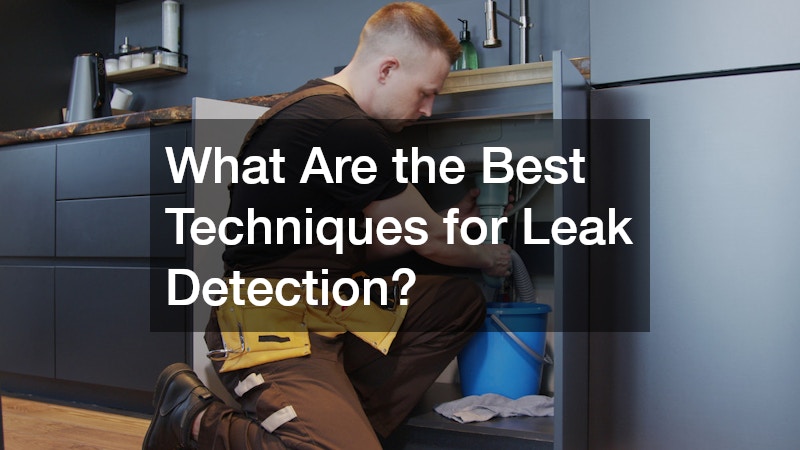Water leaks are a common but often elusive problem in both residential and commercial properties. Left undetected, even a small leak can lead to significant damage, such as mould growth, structural deterioration and increased water bills. In recent years, advancements in technology and refined methods have improved the ability to locate leaks quickly and accurately. Understanding the best techniques for leak detection is essential to minimise long-term damage and protect valuable infrastructure.
The Importance of Early Leak Identification
Early leak identification can significantly reduce repair costs and limit the damage caused by unchecked water ingress. Traditional methods of locating leaks relied heavily on guesswork or signs like damp spots, stains or dripping sounds.
By employing modern leak detection techniques, property owners can catch problems in their infancy and prevent them from escalating into major repairs or health hazards.
Moreover, in areas subject to water restrictions or high utility costs, early detection contributes to conservation efforts and reduces unnecessary expenditure. Water sustainability is an increasing concern across Australia, making timely identification of leaks not just a maintenance issue, but also an environmental responsibility.
Acoustic Leak Detection
One of the most widely used techniques in modern plumbing diagnostics is acoustic leak detection. This method uses sensitive listening devices to identify the sound made by water escaping from a pipe. Because water under pressure makes a distinct noise as it moves through a crack or hole, trained technicians can isolate the location of a leak even if it is underground or behind a wall.
Acoustic sensors can detect subtle differences in frequency and intensity, allowing professionals to distinguish between normal pipe noises and those associated with leaks. While highly effective in quiet environments, this method may be less accurate in noisy or highly trafficked areas. Nonetheless, it remains a preferred technique due to its non-invasive nature and the speed at which it can be deployed.
Thermal Imaging
Thermal imaging cameras provide another non-invasive solution for leak detection. These devices identify changes in surface temperature that may suggest the presence of moisture. Leaks often create cold or warm spots on walls, floors or ceilings, depending on the temperature of the escaping water. A thermal camera highlights these temperature anomalies, helping technicians to pinpoint the problem area.
This method is particularly valuable in detecting leaks within hot water systems, radiant floor heating or insulated walls. It allows for rapid diagnosis without the need to dismantle structures or guess at the origin of the leak. For optimal results, thermal imaging should be used in conjunction with other diagnostic methods.
Tracer Gas Technology
For situations where acoustic or thermal techniques may not suffice, tracer gas detection offers a highly precise alternative. In this method, an inert gas—typically a mix of hydrogen and nitrogen—is introduced into the water system. As the gas escapes through the leak, it rises to the surface and can be detected using a sensitive gas sensor.
Tracer gas is safe, non-toxic and capable of identifying leaks in even the smallest pipes or hardest-to-reach areas. This technique is especially useful in complex systems, such as multi-storey buildings or industrial facilities, where pinpoint accuracy is required. Due to the specialised equipment and handling procedures involved, tracer gas detection is generally performed by professional leak detection services.
Pressure Testing
Another common method used to confirm and locate leaks is pressure testing. This technique involves isolating a section of the plumbing system and monitoring pressure levels over a set period. A drop in pressure typically indicates the presence of a leak. While this method does not identify the exact location, it serves as a reliable confirmation tool and helps narrow down the search area.
Pressure testing is often used during new construction or after renovations to ensure the integrity of pipework. It also plays a key role in preventative maintenance, identifying weak points in older systems before they become problematic. To enhance its effectiveness, pressure testing is frequently paired with other detection technologies.
Moisture Mapping and Inspection
Moisture mapping involves the use of specialised meters and sensors to detect the presence of water within building materials. These tools can provide real-time readings of moisture levels in wood, concrete, drywall and other structural components. High readings indicate areas where leaks may be active or where water has pooled over time.
By analysing the spread and concentration of moisture, technicians can create a visual representation of the affected area. This approach is instrumental in identifying hidden leaks and assessing the extent of water damage. Moisture mapping is often used post-flood or after significant water exposure to guide restoration efforts and monitor drying progress.
Combining Techniques for Accuracy
No single method offers a universal solution for all leak detection scenarios. The most effective approach typically involves combining multiple techniques to increase diagnostic accuracy. By layering these methods, technicians can arrive at a precise diagnosis while minimising damage to surrounding structures.
Professional leak detection services have access to a suite of advanced tools and the expertise to interpret complex data. Hiring a specialist ensures that leaks are found efficiently and repaired promptly, reducing both short-term inconvenience and long-term costs.
Engaging qualified professionals to carry out leak detection not only safeguards your property but also contributes to water conservation and cost management. In today’s world, where every drop counts, knowing how to detect leaks effectively is an essential skill for property owners, managers and tradespeople alike.
.

